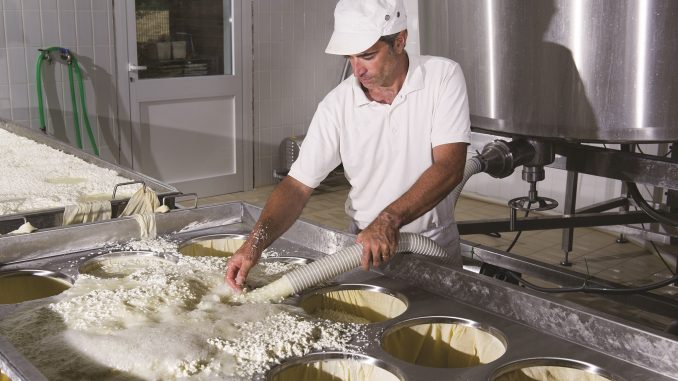
What is the big deal about rennet, and what part does it play in the cheesemaking process? Delis can help educate the growing number of consumers looking for insight.
Cheese is traditionally made with milk, salt, cultures and rennet. Rennet allows cheesemakers to efficiently turn fresh milk into curd, a technique they’ve been using for thousands of years. Over time, milk curdles on its own, but by that time, the milk may sour. Rennet speeds up this process so that proteins in the milk form curds, and the liquid separates and runs off as whey.
Not all cheese is made with rennet. Coagulation can happen in two ways: as an enzymatic reaction (rennet) or as a product of acidification (adding acid). “Ricotta is a simple example of a cheese coagulated using acid—lemon juice or vinegar, depending on the recipe,” says Elena Santogade, author of “The Beginner’s Guide to Cheese Making”. Chevré and fresh lactic cheeses are also made with acid rather than rennet, “Though some cheesemakers will add a pinch of rennet to these to insure good curd formation,” Santogade adds.
But most cheeses, from bloomy rinded Bries to aged wheels of Cheddar and beyond, are crafted with rennet, and more specifically the enzyme in rennet called chymosin. The first rennet came from the fourth stomachs of calves, lambs or goats before they consume anything other than milk—and traditional cheeses are still made with animal rennet. According to Matt Spiegler, head cheesemaker at Churchtown Dairy in Hudson, NY, “some old-school makers even use a small strip of dehydrated abomasum (the lining of a baby ruminant’s stomach), rehydrating in milk and adding to the vat, but these days rennets are generally extracted in highly-controlled laboratory settings to achieve precise levels of potency.” Churchtown Dairy uses commercially-prepared calf’s rennet.
Lab-produced vegetarian cheese coagulants have become the most common form of rennet in the marketplace. In spite of having no vegetable matter in them, they are often mistakenly referred to as vegetable rennets. The correct term for these is microbial rennet. Microbial rennet is extracted from the microbe Rhizomuchor Miehei, which produces an enzyme that acts similarly to chymosin, but without relying on animal matter. Some vegetarians seek out cheeses made with microbial rennet for this reason.
That brings us to yet another type of rennet, which is derived from plants that have been injected with cow genes. Although produced by a genetic modification, the resulting product does not contain any GMO organisms and is not a genetically-modified product. “Vegetarians seem to debate whether this fits in their ethical dietary restrictions,” says Civitello.

Vegetable Alternative
Vegetable rennet does exist; it is the least common and perhaps most distinctive of all rennet types. “Many plants have milk clotting properties,” says cheesemaking consultant Yoav Perry, founder of Artisan Geek in New York City. “Early attempts took place as early as ancient Greece with fig sap, which is still used today in some regions of Africa. Nettle is another example.” Cheshire and Gloucester cheeses were originally coagulated with the flowers of Curdwort, and occasionally combined with calf rennet for speed. The yellow pigment from the flower colored the cheese before Annatto became popular.
The most famous vegetable rennet is thistle rennet. Produced by making a “tea” from the dry pistils of the flower of Globe Thistle Artichoke (Cynara Cardunculus), it uses thistle as a coagulant and dates to the Roman Empire. The cardoon, which is related to the artichoke, was once a mainstay of ancient Roman, Greek and Persian cuisines. In De Re Rustica (On Agriculture), written during the first century, Columella details the use of wild thistle to clot milk.
Thistle rennet made its way to the Iberian Peninsula, where it was mainly used to craft hard sheep’s milk cheeses. “The vegetarian properties of this rennet also made it popular early for use in Kosher cheese with Jews prior to the Spanish Inquisition” Perry explains.
“It is said that an accident in dosage and temperature made some ‘undesirable’ cheese that was not hard enough to store, age or sell in the warm weather,” Perry says. “Accelerated proteolysis caused the paste to collapse and turn supple. This happy accident resulted in the precursor to some of the most beloved Spanish and Portuguese cheeses: Torta del Casar, Zimbro, Azeitao, Serpa, Nisa and Queso de La Serena. They have in common a tangy bitterness that crosses paths with the sweetness of sheep’s milk.
Experiments of Necessity
Like with many things, rennet experiments have often been born of necessity. During World War II, Germans had taken much of the Italian livestock—so Italian cheesemakers used pig rennet to make a traditional sheep’s milk cheese, Pecorino di Farindola. “Porcine rennet is predominantly pepsin, low chymosin and has a really interesting flavor profile,” says Brian Civitello, founder and cheesemaker at The Mystic Cheese Co. in Lebanon, CT.
Which brings us to another point—how does rennet influence the flavor of the end product, cheese? Rennet is a protease, an enzyme that breaks down proteins and peptides. While most of the rennet is lost to the whey during the cheesemaking process, a small percentage is retained in the curds of a newly-formed cheese. The residual rennet breaks down the milk protein (casein) into peptides. Those peptides can be further broken down during the ripening process by starter and non-starter lactic bacteria, yeasts and molds into amino acids, which form flavor compounds.

Breaking It Down
If all this sounds complicated and scientific, it’s because it is. “It’s really hard to isolate one single variable in cheesemaking, so it’s ultimately kind of hard to tell how rennet effects flavor,” Santogade believes.
It’s sometimes most apparent to experience the effects of rennet when something goes wrong. “Excessive rennet can produce bitterness and issues with the final texture,” says Spiegler.
Cheesemakers take rennet seriously—it is a crucial ingredient in their cheese. “As a modern cheesemaker, I want to use all the tools available to me to make the best cheese I can,” says Civitello. “At Mystic Cheese, the type of rennet I use depends on the type of cheese we are making. For example, when making a ripened toma cheese like The Twain, we employ traditional animal rennet from Walcoren because we need the proteolysis to produce its desired complex flavor profile. While in Melville, producing a fresh Stracchino cheese, we employ a synthetic chymosin camel-based rennet called Chy-max M because of its high clotting to low proteolytic ratio, which aids in producing a high-moisture, high-yield cheese that has very little structural breakdown during its short shelf life. Animal-based rennets can be purchased in powder, tablet, paste or liquid form. Vegetable and synthetic rennet are typically found in liquid form. Whether animal, vegetable or microbial, rennet plays a crucial role in making cheese. DB



